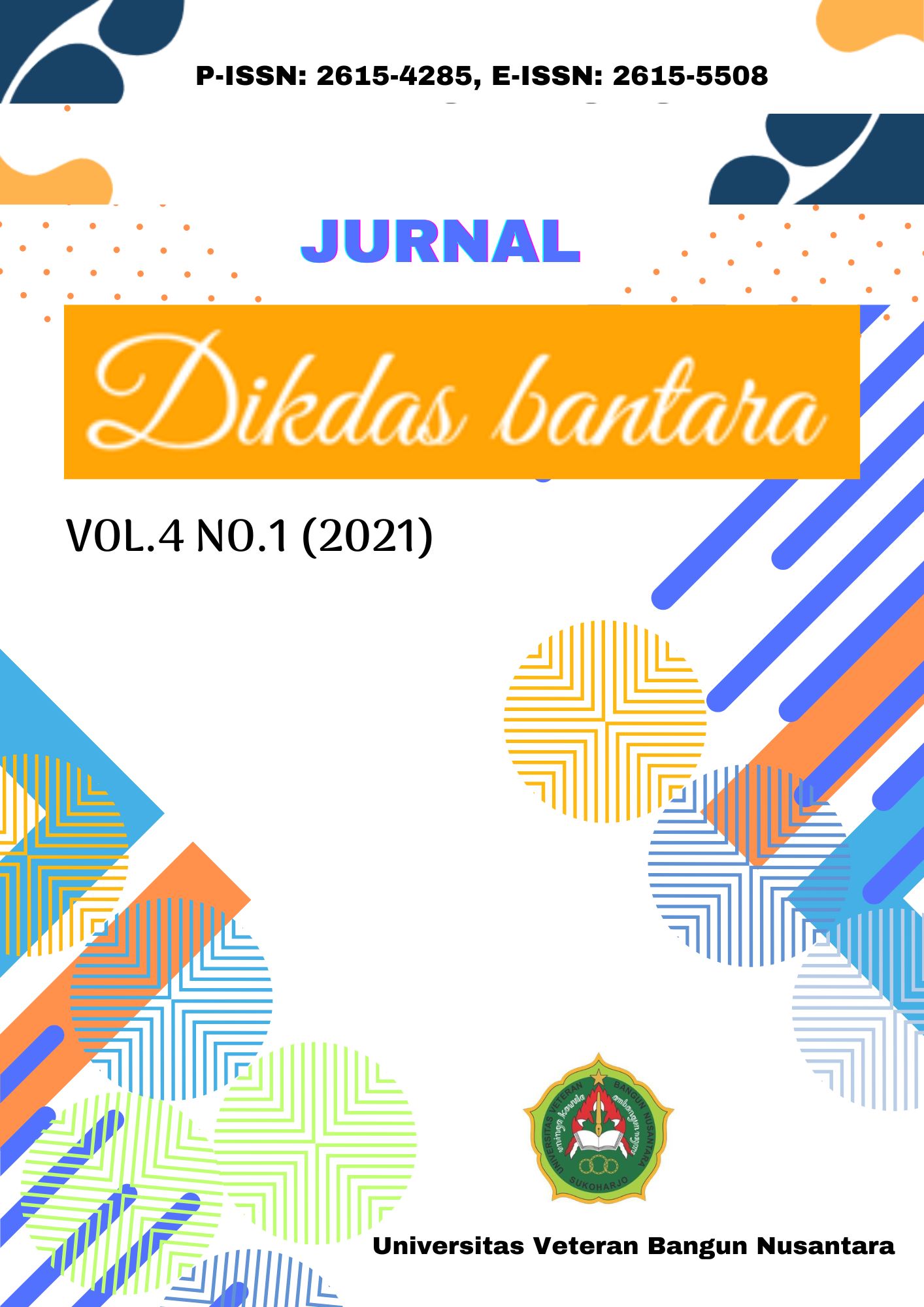UPAYA MENINGKATKAN KEMAMPUAN MENGAJAR GURU DENGAN MODEL PEMBELAJAAN JIGSAW MELALUI IN HOUSE TRAINING
DOI:
https://doi.org/10.32585/dikdasbantara.v4i1.1228Abstract
Tujuan penelitian tindakan sekolah ini adalah 1) Pembelajaran model jigsaw dapat meningkatkan proses pelaksanaan pembelajaran melalui in house training di SDN 4 Wonoboyo tahun pelajaran 2019/2020. 2) Pembelajaran model jigsaw dapat meningkatkan kemampuan mengajar guru 3) Pembelajaran Model Jigsaw dapat meningkatkan perubahan perilaku guru.Penelitian ini didesain dalam dua siklus. Prosedur siklus mencakup tahap-tahap : 1) perencanaan tindakan perbaikan, 2) pelaksanaan tindakan, 3) analisis dan refleksi, 4) tindak lanjut. Data hasil observasi dideskripsikan, diinterpretasikan, kemudian direfleksi untuk menentukan tindakan perbaikan pada siklus berikutnya. Data hasil tes hasil belajar dianalisis antar siklus hingga hasilnya dapat mencapai batas tuntas sesuai indikator kinerja, yakni 1) mencapai ketuntasan klasikal proses pembelajaran 83%, 2) memperoleh ketuntasan kemampuan belajar mencapai 83% 3)Mencapai perubahan perilaku 83% dari jumlah peserta keseluruhan.Berdasarkan tindakan yang dilakukan dapat disimpulkan sebagai berikut : 1) Persentase proses pembelajaran pada prasiklus diperoleh rata-rata persentase sebesar 16,67% dengan kategori kurang baik. Pada siklus I diperoleh rata-rata persentase sebesar 61,11% berada pada kategori cukup baik. Pada siklus II diperoleh rata-rata persentase sebesar 88,89% berada pada kategori baik 2) Peningkatan ini ditunjukkan dengan persentase ketuntasan pada prasiklus 50%, pada Siklus I yang tuntas menjadi 83,33% dan pada siklus II menjadi 100%.
Kata kunci : In House Training,Model Jigsaw,Proses Pembelajaran,Kemampuan Mengajar dan Perilaku pembelajaranDownloads
References
Arsyad, M.Azhar. 2009. Media Pembelajaran. Jakarta : Raja Grafindo Persada
Arikunto, Suharsimi. 2009. Dasar-Dasar Evaluasi Pendidikan. Jakarta : Rineka Cipta
Akhmat Sudrajat. 2008. Pengertian Pendekatan, Strategi, Metode, Tekhnik, Taktik, dan Model Pembelajaran. Bandung : Sinar Baru Algensindo.
Ahmad Barizi & Muhammad Idris. 2010. Menjadi Guru Unggul. Jogjakarta: ArRuzz Media.
Isjoni. (2010). Cooperative Learning (Efektivitas Pembelajaran Kelompok). Bandung:Alfabeta
Ibrahim.(2000).Pembelajaran kooperatif. Surabaya: University Press
Kunandar. 2007. Guru Profesional : Implementasi Kurikulum Tingkat Satuan
Pendidikan (KTSP) dan Sukses dalam Sertifikasi Guru. Jakarta : Raja Grafindo Persada.
Majid. 2013. Strategi Pembelajaran. Bandung : PT Remaja Rosdakarya
Mardiana.2013 Penerapan Pembelajaran Kooperatif Tipe Jigsaw untuk
Meningkatkan Hasil Belajar IPA siswa kelas V .
Milman Yusdi. (2010). Penilaian Prestasi Kerja. Jakarta: Balai Pustaka
Moh. Uzer Usman. 2005. Menjadi Guru Profesional. Bandung : Remaja
Rosdakarya.
Purwanto, Ngalim, M. 2012. Administrasi dan Supervisi Pendidikan. Bandung: PT.Remaja Rosdakarya
Sigit, Soehardi. 2003. Esensi Perilaku Organisasi. Penerbit Lukman Offset, Yogyakarta.
Slavin, Robert E. (2005). Cooperative Learning Teori, Riset dan Praktik.
Bandung Nusa Media
Sujoko, A. (2012). Peningkatan Kemampuan Guru Mata Pelajaran Melalui In House Training. Jurnal Pendidikan Penabur
Downloads
Published
Issue
Section
License
The copyright to this article is transferred to Jurnal Dikdas Bantara if and when the article is accepted for publication under Creative Commons Attribution-ShareAlike 4.0 International License. The undersigned hereby transfers any and all rights in and to the paper including without limitation all copyrights to Jurnal Dikdas Bantara. The undersigned hereby represents and warrants that the paper is original and that he/she is the author of the paper, except for material that is clearly identified as to its original source, with permission notices from the copyright owners where required. The undersigned represents that he/she has the power and authority to make and execute this assignment.We declare that:
1. This paper has not been published in the same form elsewhere.
2. It will not be submitted anywhere else for publication prior to acceptance/rejection by this Journal.
3. A copyright permission is obtained for materials published elsewhere and which require this permission for reproduction.
Furthermore, I/We hereby transfer the unlimited rights of publication of the above-mentioned paper in whole to Jurnal Dikdas Bantara. The copyright transfer covers the right to reproduce and distribute the article, including reprints, translations, photographic reproductions, microform, electronic form (offline, online), or any other reproductions of similar nature. The corresponding author signs for and accepts responsibility for releasing this material on behalf of any and all co-authors. After submission of this agreement signed by the corresponding author, changes of authorship or in the order of the authors listed will not be accepted.
Retained Rights/Terms and Conditions
1. Authors retain all proprietary rights in any process, procedure, or article of manufacture described in the work.
2. Authors may reproduce or authorize others to reproduce the work or derivative works for the author’s personal use or for company use, provided that the source and the Jurnal Dikdas Bantara copyright notice are indicated, the copies are not used in any way that implies Jurnal Dikdas Bantara endorsement of a product or service of any employer, and the copies themselves are not offered for sale.
3. Although authors are permitted to re-use all or portions of the work in other works, this does not include granting third-party requests for reprinting, republishing, or other types of re-use.



















